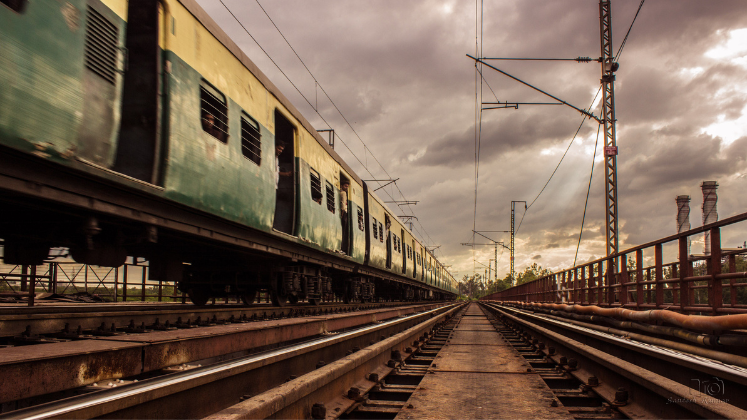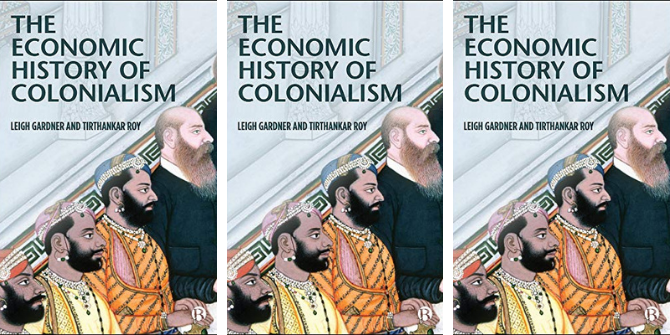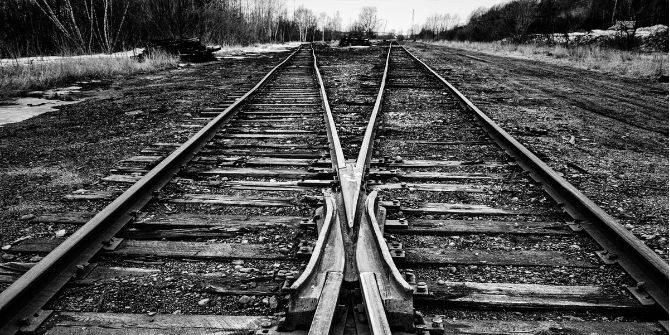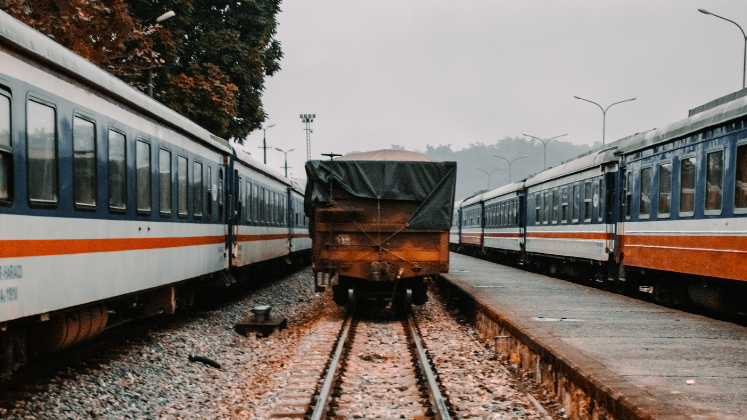In The Iron Raj, Ian D. Derbyshire explores the economic impact of the railways in India’s most populous region, present-day Uttar Pradesh, between 1860 and 1914. The book makes a methodological contribution to the economic history of colonial India and a substantial addition to the growing literature rethinking the role of the railways in shaping economic change, writes Tirthankar Roy.
Railways’ Economic Impact on Uttar Pradesh and Colonial North India (1860-1914): The Iron Raj. Ian D. Derbyshire. Cambridge Scholars Publishing, 2022.
 Find this book (affiliate link):
Find this book (affiliate link):![]()
The Iron Raj is a study of the impact of the railways in India’s most populous region, present-day Uttar Pradesh, which overlapped with the United Provinces in the colonial era. A large Himalayan river system, the Ganga-Yamuna, and tributaries water the plains. Rich alluvial soil, vast and accessible aquifers and the possibility of utilising river water for irrigation created the prospect of intensive cultivation.
During British colonial rule in India (approximately 1765-1947), military engineers responded to that opportunity with greater financial and engineering resources than before. They built and restored canals to spread the water of the two main rivers. The Ganges Canal opened in the 1850s, and in the next decade, a railway connecting Calcutta and Delhi passing through Uttar Pradesh started operation. These infrastructure projects had a profound and many-sided impact on agriculture in this part of the Indo-Gangetic Basin. It was always politically and militarily central, being a recruitment ground for the armies and a large taxpayer. For military and fiscal reasons, it became vital for the colonial government after the Indian Mutiny ended in 1858.
The Iron Raj studies the origin and impact of this new infrastructure. A big book by current standards, it builds on a close description of the process. The region is larger in population size than most European countries and diverse too. The details, therefore, can be overwhelming for the reader trying to find a central argument or a core set of evidence. Economic historians, however, should take this work seriously for two reasons. First, The Iron Raj makes a methodological contribution to the economic history of colonial India. And second, it is a substantial addition to a growing literature rethinking the role of the railways in shaping economic change.

Image Credit: ‘Glimpses of Travel’ by Santosh Kumar licensed under CC BY SA 2.0
Besides the introduction, The Iron Raj has twelve chapters. Chapter One describes the pre-railway transportation system in the region. Chapters Two to Four discuss the construction and financing of the railways and the competition between carts, boats and trains in the early days of the operation. Chapters Five to Seven concentrate on the impact on the rural economy, discussing market integration, price dispersion and stability, crop choices, grain trade and storage and the classes that were likely to accumulate capital from trade. Chapters Nine to Eleven discuss the urban economy, from trading firms to emerging industrial enterprises. Chapter Twelve revisits social savings, a well-researched subject within the Indianist railway scholarship, on which Derbyshire offers useful reflections.
A key methodological contribution of the study is that it restores the place of regions in Indian economic history. The modern debate on the economic history of India began in the 1960s with a paper by Morris David Morris, which claimed that the agency of colonialism in Indian development was less critical than nationalist historians imagined. Marxist and nationalist scholars criticised the paper. The debate occurred around generalisations about the impact of colonial rule on the Indian countryside and disregarded differences between regions. In the 1980s, historians pushed back against that tendency and brought regional specificity to the centre of the debate. The message was that there was no one story to tell about the impact of colonialism on rural development. The preconditions for significant changes in living standards depended on variables – transport access, landholding size, access to irrigation – that varied between regions.
In the 1980s, the wind was blowing for the regionalists. In the 1990s, historians of South Asia gave up doing economic history, turning to cultural history instead. In the 2000s, the ‘great divergence’ debate revived interest in Indian economic history. This asked why India fell behind the Western world; an average income represented India in the arguments and explanations that followed. Generalists came back in fashion, again directing research away from regions.
The Iron Raj takes us back to the (sensible) 1980s and restores the centrality of regions. The work for the book began in the 1980s. In 1987, Derbyshire published an article in Modern Asian Studies. The article is familiar in seminar courses on the field, including one I teach at LSE. It did what the book does on a larger scale, linking railways and regions.
The result of The Iron Raj is a more granular understanding of why railways mattered than Indiawide studies or comparative history can deliver. A flat and well-watered land, much of Uttar Pradesh was already well connected by roads and boats before the railways came. The railways changed trade by increasing the speed of cargo, reducing the cost of freight per ton per mile and the effect of seasonality upon transportation. Seasonality is an important feature of economic activity in a tropical monsoon region like India. Heavy rains and flooding made overland and river-borne trades dangerous and, in some terrains, impossible for several months a year. Railways were less susceptible to the effects of the rains and could smooth annual consumption. This accent on seasonality brings in environmental factors in a way only region-bound studies can.
A second contribution relates to the developmental impact of the Indian railways. Railway scholarship has flourished in recent years, and much new research considers the effect of the railways on market integration. More connected markets should reinforce incentives to grow more profitable crops and invest in marketing as well as give greater consumption stability. The railways were a potential anti-famine measure by smoothing inter-year variations in consumption. Uttar Pradesh has not suffered a significant drought since 1783. But the business and cropping effects were substantial.
Did markets integrate? Did prices become more stable and fluctuations reduce because of the railways? Recent research has been open-ended on this question, though the evidence to conclude in favour of integration seems stronger. The descriptive data discussed in The Iron Raj is compelling enough for the purpose. It rightly claims that large-scale statistical tests of integration often overlook the interaction between infrastructure and institutions. For example, railways encouraged the enlargement of trading towns where it was easier to enter contracts, settle disputes, borrow money and exchange information. The direct, measurable effect can underestimate the total impact.
A book by Ian Stone on the Uttar Pradesh canals showed how they encouraged regional specialisation. Areas that received water could switch to highly profitable but extremely water-intensive sugarcane cultivation, leaving less endowed areas to specialise in grains. The railways complete the story. By interconnecting subregions, it stimulated intra-Uttar Pradesh trade.
Most economic histories of railways overlook business history: how grain trade led to the emergence of new types of firms, business practices, services, information exchange and consumer tastes. The two chapters dealing with these themes represent significant value added. The chapters link commercialisation with the urban economy, especially the economies of small towns, which are built around one or two leading occupations unlike the much-studied economies of port cities. Derbyshire discusses financial markets, diversity and hierarchy among trading firms, the operation of European businesses like Ralli and Volkart, industrialisation around agro-processing and trends in urbanisation. The railways shaped urban settlements and migration and adapted to emerging trades.
The Iron Raj is not an easy book to read. The missing central thesis and the 600-odd pages of text make it hardgoing, with parts reading like a collection of notes patched up together. However, even quick browsing will show why it can claim to be a significant work in the field. A lot of the research is new, especially a great deal of statistical data. Derbyshire has presented a complex narrative linking many parts – commerce, institutions, urbanisation, industrialisation, transport and living standards – persuasively. Most importantly, while railway study has evolved recently as a distinct specialism, Derbyshire integrates railway history with the economic history of the biggest region of India.
Note: This review gives the views of the author, and not the position of the LSE Review of Books blog, or of the London School of Economics and Political Science. The LSE RB blog may receive a small commission if you choose to make a purchase through the above Amazon affiliate link. This is entirely independent of the coverage of the book on LSE Review of Books.






